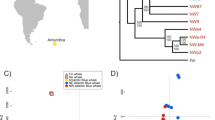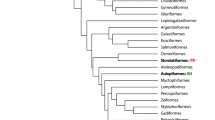Abstract
Lingcod, Ophiodon elongatus, is a nest-guarding marine fish of western North America. Breeding occurs in late winter and early spring after males establish territories and guard nest sites therein. Eggs deposited as clutches in the nest site hatch ∼7 weeks after fertilization. We evaluated the level of genetic variation in lingcod spawning in the central Strait of Georgia through analysis of microsatellite and mitochondrial D-loop variability in fertilized egg samples collected from guarded clutches. Reconstructed parental genotypes displayed a high level of allelic diversity and observed heterozygosity (83–91%) over five microsatellite loci. Progeny of a single clutch were invariably derived from a single mother and between one and five fathers. Multiple egg samples were collected from inside and outside positions on 13 lingcod egg clutches in February 2002. Fin clip samples provided microsatellite genotypes for six of the nine guardian males. Analysis of between 33 and 306 eggs from each clutch indicated that each of the 13 clutches was produced by a different mother and five of them were sired entirely by the attendant male guardian. Eight clutches were sired by multiple males, with neighboring male guardians frequently involved in clutch fertilization. Known guardian males accounted for at least 78% of observed egg fertilization, although non-territorial males were observed and may have participated in spawning. Egg fertilization by individual males was spatially heterogeneous throughout egg clutches. One male guardian failed to fertilize detectable numbers of eggs in his own or any other clutch within the study area and may have been an adoptive father. The polygynous mating structure of lingcod may help maintain genetic variation in the species.
Similar content being viewed by others
References
Blumer, L.S. 1979. Male parental care in the bony fishes. Quart. Rev. Biol. 54: 149–161.
Cass, A.J., R.J. Beamish & G.A. McFarlane. 1990. Lingcod (Ophiodon elongatus). Can. Spec. Publ. Fish. Aquat. Sci. 109: 40.
Clutton-Brock, T.H. 1989. Mammalian mating systems. Proc. R. Soc. Lond (B) 236: 339–372.
Clutton-Brock, T.H. 1991. The Evolution of Parental Care, University of Princeton Press, Princeton, NJ, 368 pp.
Constantz, G.G. 1985. Allopaternal care in the tessellated darter, Etheostoma olmstedi. Env. Biol. Fish. 14: 175–183.
Crow, K.D., D.A. Powers & G. Bernardi. 1997. Evidence for multiple maternal contributors in nests of kelp greenling (Hexagrammos decagrammus, Hexagrammidae). Copeia 1997: 9–15.
DeWoody, J.A. & J.C. Avise. 2001. Genetic perspectives on the natural history of fish mating systems. J. Hered. 92: 167–172.
DeWoody, J.A., D.E. Fletcher, S.D. Wilkins, W.S. Nelson & J.C. Avise. 1998. Molecular genetic dissection of spawning, parentage and reproductive tactics in a population of redbreast sunfish, Lepomis auritus. Evolution 52: 1802–1810.
Garant, D., J.J. Dodson & L. Bernatchez. 2001. A genetic evaluation of mating system and determinants of individual reproductive success in Atlantic salmon. J. Hered. 92: 137–145.
Garcia-Vazquez, E., P. Moran, J.L. Martinez, J. Perez, B. de Gaudemar & E. Beall. 2001. Alternative mating strategies in Atlantic salmon and brown trout. J. Hered. 92: 146–149.
Giorgi, A.L. & J.L. Congleton. 1984. Effects of current velocity on development and survival of lingcod, Ophiodon elongatus, embryos. Env. Biol. Fish. 10: 15–27.
Goto, A. 1993. Male mating success and female mate choice in the river sculpin, Cottus nozawae (Cottidae). Env. Biol. Fish. 3: 347–353.
Hedrick, P.W. 2000. Genetics of Populations. 2nd edition, Jones and Bartlett, Portola Valley, CA, 576 pp.
Jennions, M.D. & M. Petrie. 2000. Why do females mate multiply? Biol. Rev. 75: 21–64.
Jewell, E.D. 1968. SCUBA diving observations on lingcod spawning at a Seattle breakwater. Washington Department of Fisheries Research Paper 3: 27–36.
King, J.R. & B.W. Beaith. 2001. Lingcod (Ophiodon elongatus) nest density SCUBA survey in the Strait of Georgia, January 16-April 26, 2001. Can. Tech. Rep. Fish. Aquat. Sci. 2374: 21.
LaRiviere, M.G., D.D. Jessup & S.B. Mathews. 1981. Lingcod, Ophiodon elongatus, spawning and nesting in San Juan channel, Washington. Calif. Fish. Game 67: 231–239.
Low, C.J. & R.J. Beamish. 1978. A study of the nesting behaviour of lingcod (Ophiodon elongatus) in the Strait of Georgia, British Columbia. Fish. Mar. Sci. Tech. Rep. No. 843, 27 p.
Martell, S.J.D., C.J. Walters & S.S. Wallace. 2000. The use of marine protected areas for conservation of lingcod (Ophiodon elongatus). Bull. Mar. Sci. 66: 729–743.
Matthews, K.R. 1992. A telemetric study of the home ranges and homing routes of lingcod Ophiodon elongatus on shallowrocky reefs off Vancouver Island, British Columbia. Fish. Bull. 90: 784–790.
Miller, K.M., T.J. Ming, A.D. Schulze & R.E. Withler. 1999. Denaturing gradient gel electrophoresis (DGGE): A rapid and sensitive technique to screen nucleotide sequence variation in populations. Biotechniques 27: 1016–1030.
Natsumeda, T. 1998. Size-assortative nest choice by the Japanese fluvial sculpin in the presence of male-male competition. J. Fish Biol. 53: 33–38.
Neff, B.D. 2001. Genetic paternity analysis and breeding success in bluegill sunfish (Lepomis macrochirus). J. Hered. 92: 111–119.
Sargent, R.C. 1989. Allopaternal care in the fathead minnow, Pimephales promelas: Stepfathers discriminate against their adopted eggs. Behav. Ecol. Sociobiol. 25: 379–385.
Smith, B.D., G.A. McFarlane & A.J. Cass. 1990. Movements and mortality of tagged male and female lingcod in the Strait of Georgia, British Columbia. Trans. Amer. Fish. Soc. 119: 813–824.
Snedecor, G.W. & W.G. Cochran. 1967. Statistical Methods. 6th edition, Iowa State University Press, Ames, Iowa, 593 pp.
Storz, J.F., H.R. Bhat & T.H. Kunz. 2001. Genetic consequences of polygyny and social structure in an Indian fruit bat, Cynopterus sphinx. II. Variance in male mating success and effective population size. Evolution 55: 1224–1232.
Taborsky, M. 2001. The evolution of bourgeois, parasitic and cooperative reproductive behaviors in fishes. J. Hered. 92: 100–110.
Thompson, J.D., T.J. Gibson, F. Plewniak, F. Jeanmougin & D.G. Higgins. 1997. The ClustalX windows interface: Flexible strategies for multiple sequence alignment aided by quality analysis tools. Nucl.s Acids Res. 24: 4876–4882.
Author information
Authors and Affiliations
Rights and permissions
About this article
Cite this article
Withler, R.E., King, J.R., Marliave, J.B. et al. Polygamous Mating and High Levels of Genetic Variation in Lingcod, Ophiodon elongatus, of the Strait of Georgia, British Columbia. Environmental Biology of Fishes 69, 345–357 (2004). https://doi.org/10.1023/B:EBFI.0000022898.49007.bc
Issue Date:
DOI: https://doi.org/10.1023/B:EBFI.0000022898.49007.bc




